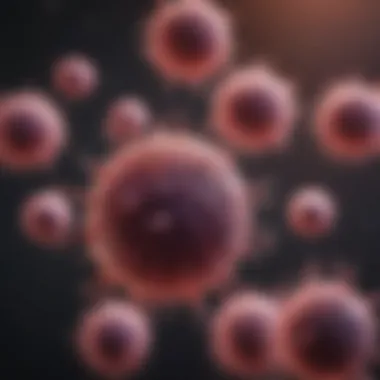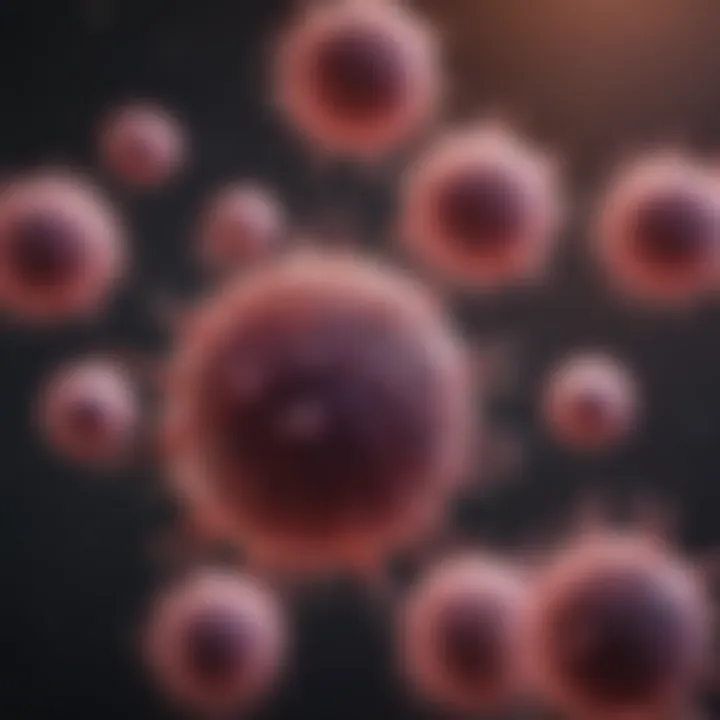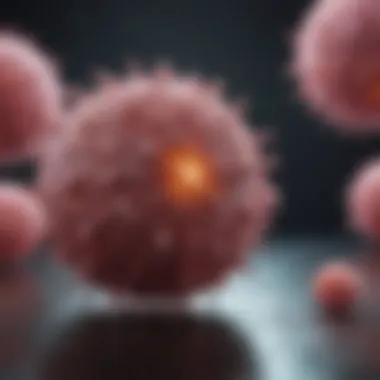T Cell Immune Response in Breast Cancer: Insights and Strategies


Intro
Breast cancer remains a significant health challenge globally, impacting countless individuals and families. Understanding the immune system's role in combating this disease is essential for developing effective treatments. T cells, a critical component of the immune system, exhibit intricate dynamics that can influence tumor progression and response to therapies. This article aims to shed light on these T cell dynamics, offering insight into mechanisms that govern their activation and highlighting the challenges posed by tumor microenvironments.
With recent advancements in cancer research, there’s a growing interest in how T cell responses are manipulated for therapeutic purposes. The link between a patient’s immune response and tumor characteristics becomes more apparent as we delve deeper into this topic. By examining how T cells engage with cancer cells, we can uncover strategies to improve treatment outcomes. This exploration mirrors a broader trend in oncology, where the focus is increasingly shifting towards personalized approaches rooted in immunological principles.
As we proceed, the narrative will weave through key aspects of T cell activation, the challenges they face within the tumor microenvironment, and the potential avenues for harnessing their capabilities to bolster therapeutic efficacy. In doing so, we hope to paint a clearer picture of the intersection between T cell biology and breast cancer, engaging students, researchers, educators, and professionals in this crucial discourse.
Intro to T Cell Immunology in Breast Cancer
The interplay of the immune system with cancer cells is a central theme in understanding how breast cancer develops, progresses, and responds to treatment. T cell immunology forms the backbone of this interaction, offering insights into potential treatment modalities that could tip the scales in favor of patient outcomes. In breast cancer, the multifaceted nature of T cells—their types, activation signals, and interactions with tumor cells—needs thorough exploration.
Understanding the mechanisms behind T cell responses is crucial for several reasons. First, it can illuminate how effective the immune system is at recognizing and combating breast cancer. Second, by digging into the specifics of T cell activation and the factors that inhibit their function, we can come closer to identifying potential therapeutic targets.
In the context of breast cancer, T cells can either aid in tumor suppression or, when dysfunctional, contribute to tumor progression. Finding strategies that enhance T cell efficacy, while simultaneously mitigating any negative influences from the tumor microenvironment, can provide critical advances in treatment methodologies.
"The immune functionality, specifically of T cells, determines how well the patient can fend off cancer cells that propagate the disease."
Moreover, the implications stretch beyond patient treatment. Insights gained from T cell immunology can shape future research, ensuring that immunotherapy approaches are fine-tuned to tackle the specific challenges presented by breast cancer subtypes.
Overview of T Cells and Their Function
T cells, a subset of lymphocytes, play a pivotal role in the immune response. They originate from hematopoietic stem cells in the bone marrow, but their maturation occurs in the thymus. Two main types dominate the discourse in oncology: CD4+ (helper) T cells and CD8+ (cytotoxic) T cells.
- CD4+ T cells assist in orchestrating the immune response. They aid other cells by releasing cytokines, which signal other immune cells to perform their functions more effectively. This makes them crucial in the formation of robust immune responses against tumors.
- CD8+ T cells, on the other hand, are the front-line soldiers that directly target and eliminate cancerous cells. They recognize specific antigens presented by major histocompatibility complex (MHC) molecules on tumor cells and, upon activation, can induce apoptosis in these cells.
In addition to these, regulatory T cells (Tregs) are another important group that maintains immune homeostasis but can also suppress anti-tumor responses, making their role a double-edged sword in cancer environments.
Thus, understanding how T cells function is not merely an academic exercise. It equips researchers and clinicians with tools to manipulate these cells for therapeutic gains, highlighting the critical balance of T cell activity in the context of tumors.
The Relevance of T Cells in Oncology
T cells are not just players in the immune system; they are pivotal in shaping the response to cancer therapies. Their relevance in oncology can be accounted for through several lenses:
- Tumor Surveillance: T cells have the natural ability to recognize and eliminate abnormal cells. Their efficacy in tumor surveillance can lead to the eradication of cancer cells before they proliferate.
- Biomarkers for Response: The presence of T cells within tumor microenvironments often correlates with positive clinical outcomes. This association can be harnessed to predict treatment responses and to personalize therapeutic strategies.
- Foundation for Immunotherapy: With the rise of immunotherapeutic strategies, T cells have become the focal point. Therapies that enhance T cell responses, such as immune checkpoint inhibitors or CAR T cell therapy, have shown promise in helping the immune system recognize and combat breast cancer.
The tangential relationship of T cells with cancer makes them a crucial subject of study, intertwining healthcare strategies that hinge on understanding immune responses to drive advancements in treatment outcomes.
Types of Breast Cancer and Their Immunological Profiles
Understanding the types of breast cancer and their immunological profiles is key to comprehend how T cells can be both allies and adversaries in cancer therapy. Different breast cancer types possess unique cellular characteristics and immune engagements, ultimately affecting treatment strategies. By identifying how T cells interact with these different cancer subtypes, researchers and clinicians can tailor therapies that enhance immune efficacy and improve patient outcomes. Here, we will dissect three predominant categories of breast cancer: hormone-receptor positive, triple-negative, and HER2-positive, each offering distinct challenges and opportunities for T cell response.
Hormone-Receptor Positive Breast Cancer
Hormone-receptor positive breast cancer accounts for about 70% of breast cancer diagnoses. This subtype typically expresses receptors for estrogen and/or progesterone, making it sensitive to hormonal therapies. T cells in this category can behave in different ways. In some cases, these breast cancers can effectively attract T cell responses through tumor antigens presented by hormone-driven mechanisms. However, the tumor microenvironment can also support immune evasion, employing tricks to dampen the T cell activity.
In hormone-receptor positive cancers, it is essential to understand the interplay between hormonal treatment and immune activation. For instance, therapies that block estrogen can sometimes paradoxically enhance the immune response by modulating T cell activity within the tumor site. On the flip side, prolonged exposure to hormonal treatments might allow tumors to develop adaptations that contribute to immune resistance.
Triple-Negative Breast Cancer
Triple-negative breast cancer (TNBC) stands out due to its lack of expression of hormone receptors and the HER2 protein. This subtype often has a more aggressive disease course and a poorer prognosis. On the immunological front, TNBC is quite heterogeneous; some tumors can trigger a robust T cell response, while others may suppress it. Immune checkpoints, for example, can be upregulated in TNBC, creating conditions ripe for immune evasion.
This immunogenic landscape makes TNBC a prime candidate for immunotherapy. Innovative approaches, such as PD-1 or PD-L1 inhibitors, aim to reactivate T cell function in these cases. However, navigating the complexities of T cell dynamics remains essential. The relationship between tumor mutation burden and T cell response can vary, urging researchers to discover specific biomarkers for predicting treatment success in TNBC.


HER2-Positive Breast Cancer
HER2-positive breast cancer, characterized by overexpression of the HER2/neu protein, presents another unique challenge. This subtype can elicit a robust immune response, particularly due to the presence of HER2 antigens that can be recognized by T cells. However, the tumor’s ability to modulate the immune response can lead to complexities in therapy.
Therapies like trastuzumab (Herceptin) have shown efficacy in treating HER2-positive breast cancer, not simply by targeting the HER2 protein but also by enhancing antibody-dependent cellular cytotoxicity (ADCC) brought about by T cells. The synergy between targeted therapies and T cell activation proves promising. Yet, as the tumor microenvironment often helps tumors switch on mechanisms of immune evasion, continuous inquiry into how T cells interact with these environments remains critical to optimizing treatment.
"The tumor microenvironment is constantly changing; hence adapting our understanding of immune interactions for each breast cancer subtype is vital to improving therapy outcomes."
These distinct immunological profiles among breast cancer types highlight the necessity for tailored immunotherapies. The multifaceted interactions between T cells and tumor cells can ultimately guide treatment decisions, offering doses of hope in the battle against breast cancer.
T Cell Activation and Response Mechanisms
Understanding T cell activation and response mechanisms is central to comprehending how the immune system can be harnessed in breast cancer treatment. T cells are like the body’s soldier, seeking out and destroying cancer cells while also being guided by a complex orchestration of signals and interactions in their environment. Without proper activation, T cells may remain dormant, unable to combat malignancies effectively.
Antigen Presentation and Recognition
Antigen presentation is a cornerstone of T cell activation. When dendritic cells or other antigen-presenting cells (APCs) process a tumor antigen, they display fragments of this antigen on their surface via Major Histocompatibility Complex (MHC) molecules.
There are two main types of MHC: MHC class I, which presents to CD8+ cytotoxic T cells, and MHC class II, for CD4+ helper T cells.
The initial recognition of antigens is more than a mere handshake; it's a detailed interrogation. T cells express T cell receptors (TCRs) that must bind specifically and tightly to these peptide-MHC complexes. This critical step can mean the difference between successful immune response and failure.
"The interaction between TCRs and peptides presented by MHC is not random; it’s based on a precise molecular fit resembling a key in a lock."
In many cases, tumors evolve to present altered or less recognizable antigens, complicating this recognition process. This challenge underscores the necessity of understanding specific tumor antigens to improve immunotherapies.
Cytokine Signaling Pathways
Once T cells recognize their specific antigen, a cascade of biochemical reactions is initiated involving cytokine signaling pathways. Cytokines are like the chemical messengers of the immune system, influencing and directing the activity of T cells.
Key cytokines such as Interleukin-2 (IL-2), Tumor Necrosis Factor-alpha (TNF-alpha), and Interferon-gamma (IFN-gamma) play pivotal roles in modulating T cell proliferation, differentiation, and survival.
For instance, IL-2 is essential for T cell clonal expansion, ensuring that once activated, T cells multiply adequately to mount an effective response against tumors. Additionally, IFN-gamma activates macrophages and enhances antigen presentation, thereby creating a more hostile environment for tumor cells.
However, the tumor microenvironment often produces cytokines that can skew the immune response. Thus, understanding these signaling pathways is crucial for designing therapies that can enhance T cell function while mitigating negative regulatory effects from the tumor.
Role of Co-stimulatory Signals
Activation of T cells is not just about antigen recognition and cytokine signaling. Co-stimulatory signals, akin to an energetic pep talk, are essential to fully activate T cells. The most well-studied molecules in this category are CD28 and its ligands, CD80 and CD86, found on the surface of APCs.
When a T cell binds to an antigen-MHC complex, this initial signal must be complemented by a second signal from these co-stimulatory molecules. This two-signal model creates a robust activation process, leading to clonal expansion and effector function. If the second signal is absent, it can lead to T cell anergy, where T cells become unresponsive.
In the setting of breast cancer, many tumors express negative co-stimulatory molecules, such as Programmed Death-Ligand 1 (PD-L1), which can block the function of T cells. This highlights the importance of not only understanding the activation signals but also the broader context of interactions affecting T cell responses.
Tumor Microenvironment and T Cell Interactions
The interplay between T cells and the tumor microenvironment (TME) in breast cancer is intricate and multifaceted. The TME consists of the cellular structures, signaling molecules, and the extracellular matrix surrounding a tumor, all of which significantly influence T cell behavior and, consequently, immune responses. Here, the focus is on understanding how various elements within the TME contribute to T cell interactions and modulate the immune response against breast cancer.
The Immune Suppressive Landscape in Breast Cancer
In breast cancer, the immune suppressive landscape poses a formidable barrier to effective anti-tumor immunity. Tumors often release a mix of cytokines and chemokines that encourage the recruitment of immunosuppressive cells such as regulatory T cells (Tregs) and myeloid-derived suppressor cells (MDSCs). These cells dampen the T cell response, making it difficult for the immune system to recognize and eliminate cancer cells.
Several studies highlight that the presence of Tregs is often correlated with poor prognosis in breast cancer patients. They secrete inhibitory factors such as IL-10 and TGF-β, promoting an environment that supports tumor growth rather than an immune attack. MDSCs, on the other hand, can suppress T cell activation and proliferation as well, linking the immune evasion mechanisms back to the TME's ability to create a shield against the immune system.
Cellular Components of the Tumor Microenvironment


Breast tumors are not just a collection of malignant cells; they are a rich ecosystem inhabited by various cell types that contribute to tumor progression. The cellular components of the TME include:
- Fibroblasts: These cells can adopt a myofibroblastic phenotype in tumors, producing collagen and other components that create physical barriers to T cell infiltration.
- Endothelial Cells: The formation of abnormal blood vessels, or angiogenesis, can result in the improper delivery of immune cells to the tumor site, creating a hostile environment for T cells.
- Immune Cells: Besides Tregs and MDSCs, other immune cells present in the TME include macrophages and dendritic cells, which can either promote an immune response or suppress it, depending on their activation state.
Understanding these components is critical for developing strategies that can manipulate the TME to favor T cell activation and enhance anti-tumor immunity.
Metabolic Adaptations of Tumor Cells
Metabolic reprogramming is a hallmark of cancer, affecting not just the tumor cells themselves but also how they interact with the immune system. Tumor cells often undergo metabolic adaptations that allow them to thrive in the nutrient-depleted and hypoxic conditions typical of the TME. This reprogramming can impact T cell function in several ways:
- Nutrient Competition: Breast cancer cells can outcompete T cells for essential nutrients such as glucose and amino acids. This can lead to T cell dysfunction and reduced cytotoxicity.
- Lactic Acid Production: Tumor cells often produce lactic acid through aerobic glycolysis, leading to an acidic microenvironment. This acidity can impair T cell proliferation and cytokine production, hampering their ability to mount an effective response against the tumor.
- Altered Signaling Pathways: The metabolic changes in tumor cells can also affect signaling pathways involved in T cell activation and differentiation, reinforcing a cycle of immune evasion.
Challenges in T Cell Therapy for Breast Cancer
T cell therapy has emerged as a beacon of hope in the treatment of breast cancer, yet this approach is not without significant hurdles. Understanding these challenges is crucial, not only for researchers but also for clinicians who aim to leverage T cell responses effectively in patient care. The difficulties inherent in T cell therapy often stem from the complex interplay between T cells and the tumor microenvironment, immune system dynamics, and individual patient variations.
Immune Evasion Mechanisms in Tumors
Tumors have developed a number of cunning strategies to dodge or suppress the immune response, particularly against T cells. One primary mechanism is the expression of immune checkpoint proteins like PD-L1. When cancer cells present these proteins, they can bind to PD-1 receptors on T cells, essentially signaling the immune cells to "stand down." This inhibitory interaction can prevent T cells from mounting effective attacks against the tumor, allowing cancer to thrive unchallenged.
Furthermore, some tumors can create an immunosuppressive microenvironment by secreting cytokines like TGF-beta, which hampers T cell activity and promotes regulatory T cells (Tregs), further muting potential immune responses. In this high-stakes game of cat and mouse, tumors are not merely passive targets; they evolve alongside T cell therapies, complicating treatment efficacy.
- Tumor-associated antigens (TAAs) can also vary, reducing T cell recognition.
- The presence of immunosuppressive cells like myeloid-derived suppressor cells (MDSCs) can further exacerbate T cell dysfunction.
Resistance to Immunotherapy
Despite the initial promise of immunotherapy, resistance remains a significant barrier to patient success. Some patients may show initial responsiveness to therapies such as checkpoint inhibitors but ultimately develop resistance. This phenomenon can arise from both intrinsic factors, like genetic mutations within tumor cells, and extrinsic influences, including changes in the tumor microenvironment.
Research indicates that a tumor's genomic landscape may influence how effectively T cells can target it. For instance, certain mutations can lead to alterations in tumor antigens, thereby making them less recognizable to T cells. In cases of triple-negative breast cancer, the lack of defined targets makes it particularly challenging, as these tumors are often more aggressive and less responsive to conventional treatment methods.
Adverse Effects of T Cell Targeted Therapies
While T cell therapies hold promise, they are not without a price. Adverse effects can arise, sometimes leading to more serious complications than the cancer itself. One well-documented issue is immune-related adverse events (irAEs), where the T cells mistakenly attack healthy tissues, resulting in conditions such as colitis, dermatitis, or even endocrinopathies like thyroid dysfunction.
Moreover, the intensity of the immune response can lead to cytokine release syndrome (CRS), which brings about severe inflammatory responses that can be life-threatening. Patients often face a balancing act; they seek to harness their immune system's power without it turning against the body.
- The delicate equilibrium required for T cell function implies that boosting the immune response is a double-edged sword.
- Long-term effects of T cell therapies are still under exploration, creating uncertainty in treatment regimens.
In summary, while T cell therapy showcases remarkable potential in breast cancer treatment, comprehensive strategies are essential to counter the challenges posed by immune evasion, therapeutic resistance, and adverse effects. Addressing these factors is vital to advancing the efficacy of immunotherapies and, ultimately, improving patient outcomes in the realm of oncology.
Innovative Therapeutic Approaches Leveraging T Cells
The landscape of breast cancer management is ever-evolving, significantly influenced by the advances in T cell-based therapies. These innovative approaches not only enhance therapeutic efficacy but also address the complexities surrounding tumor biology and immune evasion. By harnessing the power of T cells—specifically, their ability to recognize and attack malignant cells—researchers and clinicians are carving out new paths in the battle against breast cancer.
With the rise of immunotherapy, there is a renewed focus on developing strategies that can effectively engage T cells within the tumor microenvironment. T cells act as the body’s soldiers, poised to eliminate cancer cells. However, they often face challenges when attempting to do so within the intricate setting of tumors. Therefore, therapeutic strategies that optimize T cell activity can have profound implications for treatment outcomes. Below are key approaches that highlight the integration of T cells into breast cancer therapy.
Checkpoint Inhibitors in Breast Cancer
Checkpoint inhibitors have emerged as a cornerstone of immunotherapy, specifically targeting immune checkpoints that tumor cells exploit to evade the immune response. Drugs like pembrolizumab and nivolumab function by blocking proteins such as PD-1 and CTLA-4, which typically regulate T cell activation and proliferation.
- Mechanism: By inhibiting these checkpoints, T cells can remain active longer, allowing them to identify and destroy cancer cells more effectively.
- Efficacy: Studies have highlighted the role of these inhibitors in various breast cancer subtypes, particularly in triple-negative breast cancer, where traditional treatment options are limited.
"Checkpoint blockade reshapes the T cell response, reinvigorating the immune system's ability to combat malignancies."
The understanding that not all tumors respond equally to checkpoint inhibitors has led to ongoing research aimed at identifying predictive biomarkers. This can help clinicians tailor immunotherapy based on the unique characteristics of the tumor, enhancing treatment effectiveness.


CAR T Cell Therapy: A Novel Paradigm
Chimeric antigen receptor (CAR) T cell therapy represents a groundbreaking shift in cancer treatment, previously restricted mainly to hematological malignancies, but now being explored in solid tumors like breast cancer. This technique involves engineering a patient’s T cells to express specific receptors that recognize antigens on tumor cells.
- Advantages: The targeted nature of CAR T cells allows for a potent anti-tumor response. Unlike conventional therapies, CAR T cells can persist long-term, providing ongoing surveillance against recurrence.
- Challenges: However, CAR T cell therapy is not without its hurdles, such as the identification of appropriate tumor antigens and managing potential adverse effects, like cytokine release syndrome. The complexity of the tumor microenvironment in breast cancer necessitates further refinements to enhance the therapy’s efficacy.
Combination Therapies with T Cell Enhancers
Combining different therapeutic modalities can often yield superior results. This is particularly true when integrating T cell-targeted agents with established breast cancer treatments such as chemotherapy, radiotherapy, or hormonal therapies.
- Synergistic effects: Combining checkpoint inhibitors with chemotherapy has demonstrated enhanced T cell priming and activation.
- T cell enhancers: Agents such as cytokines (like IL-2 or IL-15) can assist in amplifying T cell responses, potentially leading to improved treatment outcomes.
Such combination strategies must be thoughtfully designed to minimize toxicity while maximizing the therapeutic impact, ensuring that T cells are primed not to just respond, but to thrive against the tumor's defenses.
In summary, innovative therapeutic approaches leveraging T cells in breast cancer signify a paradigm shift in how we understand and treat this complex disease. By focusing on enhancing T cell functionality and navigating the challenges posed by tumor microenvironments, we stand on the cusp of vastly improved strategies for combating breast cancer.
Future Directions in T Cell Research for Breast Cancer
The ongoing evolution in T cell research reflects profound implications for how we understand and approach breast cancer therapies. In particular, focusing on future directions can unveil how novel strategies may bridge the gap between immune response and environmental challenges posed by tumors. This is particularly critical as current treatment paradigms often overlook the nuances of the tumor microenvironment and how T cells navigate these complexities.
Personalized Cancer Vaccines
Personalized cancer vaccines have emerged as a promising avenue in T cell therapy. Unlike traditional vaccines, which apply a one-size-fits-all methodology, these vaccines are tailored specifically to the tumor's unique antigens. By harnessing the patient’s own T cells, oncologists aim to train them to fight cancer more effectively. Studies show that this personalized approach not only increases the likelihood of a robust immune response but also minimizes adverse effects, since the therapy is directed specifically at the tumor cells.
The effectiveness of these vaccines lies in their ability to stimulate both the cellular and humoral immune responses. Moreover, they represent a flexible strategy that can adapt to changes in tumor progression—individualizing treatment as the patient’s disease evolves.
"Personalized softens the blow of conventional treatments, making the road ahead brighter for patients fighting breast cancer."
Exploiting the Gut Microbiome for T Cell Modulation
Another fascinating avenue lies in the gut microbiome's role in modulating T cell responses. There's mounting evidence that the gut microbiota affects immunity and inflammation. It actually influences how T cells respond to antigens and their overall effector functions. This relationship opens new doors for therapy; by manipulating or enhancing a patient’s gut microbiome, clinicians could potentially boost the effectiveness of T cell responses against breast cancer.
Such gut health strategies could include prebiotics or probiotics while combining them with existing cancer therapies. In essence, understanding this interplay may provide insights into optimizing treatment plans that foster a supportive environment for T cell activation and expansion.
The Role of Genomics in Predicting T Cell Responses
The integration of genomics into T cell research holds vast potential. As we delve deeper into the genetic underpinnings of breast cancer, genomic profiling can offer distinct advantages. It allows researchers to identify specific mutations and alterations within tumors that might dictate T cell interactions.
By leveraging this genomic data, oncologists can better predict how individual tumors may respond to T cell-based therapies. For example, knowing certain mutations may lead to increased antigen presentation, thus enhancing T cell recognition. Furthermore, by understanding the genetic make-up of a patient's cancer, researchers can develop more targeted approaches that improve not just efficacy but also precision in treatment delivery.
Endings and Insights
In the increasingly complex landscape of oncology, understanding how T cells interact with breast cancer cells is paramount for developing effective treatment strategies. This section pulls together the threads of the discussion to underscore the significance of T cell dynamics in managing breast cancer.
One of the most crucial insights is the realization that T cells are not just passive observers. Instead, they actively shape the tumor microenvironment and influence tumor behavior. This intricate dance between T cells and tumor cells can determine treatment outcomes, making it essential to integrate T cell responses into holistic cancer management protocols. Recognizing that specific T cell subsets can either promote or inhibit tumor progression offers new avenues for targeted therapies.
Integrating T Cell Dynamics into Breast Cancer Management
To effectively harness the potential of T cells, it's vital to incorporate their dynamics into clinical practice. This involves:
- Assessing T Cell Profiles: Evaluating the immune repertoire of patients can provide insights into their prognosis and response to therapies. For example, the presence and activity of CD8+ cytotoxic T cells can be strong predictors of response to immunotherapy.
- Personalized Treatment Plans: Tailoring treatments based on individual T cell profiles can lead to more effective outcomes. This might include combining therapies that stimulate T cell activity alongside conventional treatments, such as chemotherapy, which can potentially yield synergistic effects.
- Monitoring T Cell Responses: Regular assessments of T cell activity throughout treatment can help clinicians identify resistance mechanisms early and adjust therapies accordingly. Tracking immune responses not only informs treatment efficacy but also helps in making predictive assessments about long-term outcomes.
This integration demands a collaborative approach, involving oncologists, immunologists, and geneticists, all working in concert to probe the immune landscape in each patient's tumor.
Implications for Clinical Practice and Research
The discussion surrounding T cells and breast cancer deeply informs both clinical practice and future research directions. Awareness of how T cells interact with cancer cells can lead to the development of innovative therapies. The implications can be summarized as follows:
- Enhanced Cancer Immunotherapy: Harnessing the power of T cells could improve existing immunotherapies, such as checkpoint inhibitors, making them more effective for a broader range of breast cancer subtypes.
- New Research Frontiers: Understanding T cell behaviors can open up new research avenues in identifying biomarkers that predict treatment responses or disease progression. Insights gained can propel studies focusing on how to manipulate the immune system most effectively against tumors.
- Patient-Centric Approaches: Emphasizing T cell dynamics encourages a shift towards personalized medicine, where treatments are tailored not just to the cancer but also to the patient’s unique immune landscape.
"Understanding the immune response against cancer is pivotal for effective treatment strategies. T cells don’t just fight tumors; they also define the tumor’s fate in many instances."







